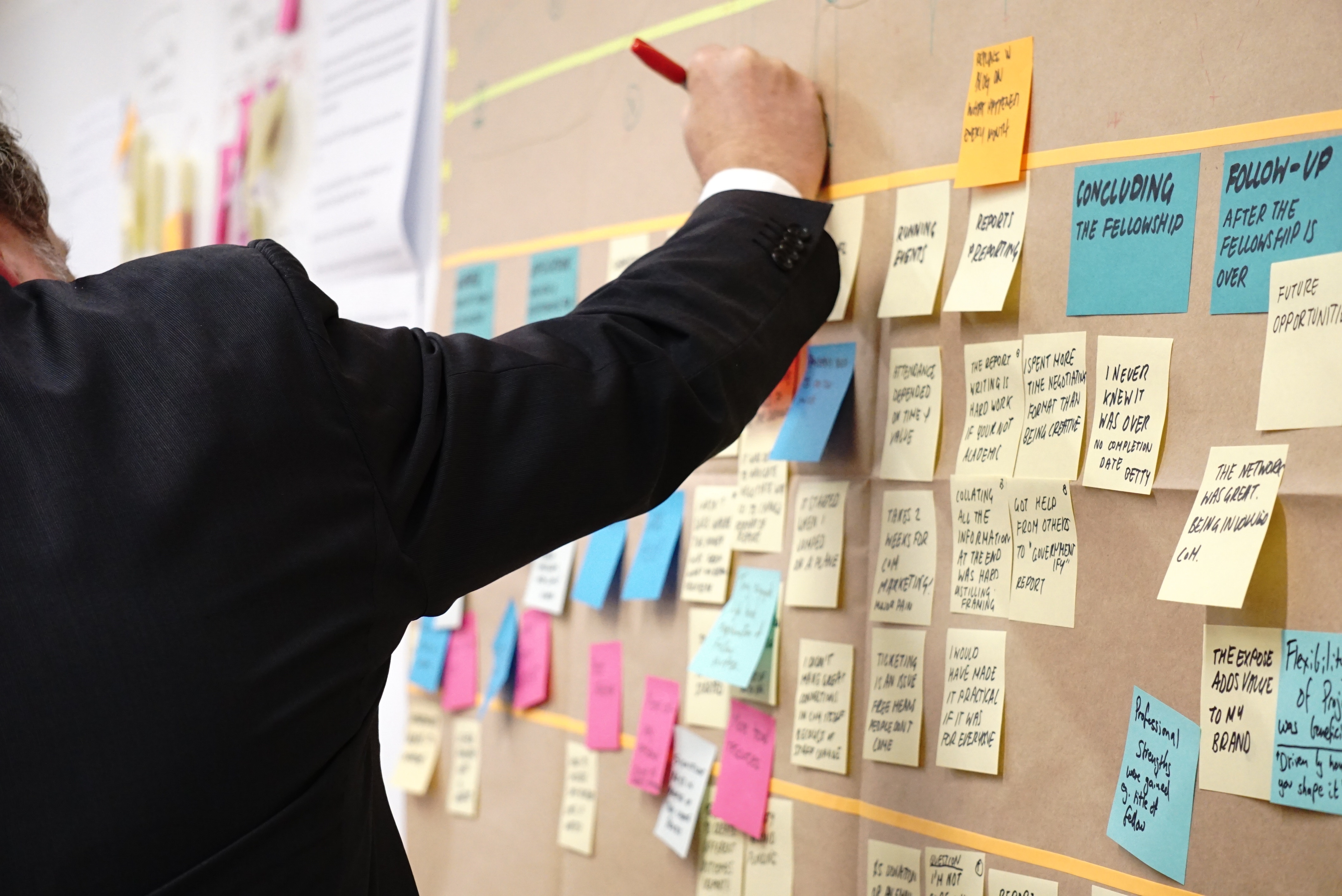ONLINE GUIDE: Actionable Habits and Tactics to Drive Leadership Success

The most effective business leaders implement impactful personal and professional habits and tactics to manage themselves, their team, and their business. Check out this online guide to learn more about how to become an even greater leader.
Business leaders have their plates full. Overflowing, really, with everything from executing strategies to ensure their company’s success to maintaining a work-life balance that still allows for quality time with family.
With so much on the go at any given time, how can you ensure you’re the most inspiring and effective leader possible? How do you make certain that you’re practicing the right habits and tactics that will positively impact your team and, ultimately, your business?
Being a great leader is all about the way you manage your team, your company, and yourself. And you’ve got to make sure that you’re in the right headspace in order to make important decisions, guide your workforce, and perform at your best. After all, taking care of your personal wellbeing is imperative for the good health of your professional life, too.
Keep reading to learn more about healthy professional and personal habits you can form, tools and solutions you can utilize, and useful tactics you can implement to ensure that both you and your company stay on the right track.
You can read the guide below or download it for free in an all-in-one PDF. The downloadable version also includes 6 impactful tactics for mastering the art of managing people as well as quick-fix tips for 4 common leadership productivity killers. Check it out by clicking the button below.
Table of Contents
Part One: Business Management
Business Management Practices to Drive Strong Organizations
Identify Your Corporate Values and Live Them
Enhance Internal Email Practices
Become a Master of Negotiation
Adopt a Customer-First Mentality
Part Two: Professional Self-Management
Mastering Professional Self-Management
Don’t Be Afraid to Think Differently
Exercise Effective Project Management
Adopt a Success-Driven Mindset
Don’t Force Yourself to be the Smartest Person in the Room
Part Three: Personal Self-Management
How to Master Your Morning Routine
How to Prevent Your Smartphone from Zapping Your Productivity
How to Adopt a Mindset That Stimulates Success
Embracing the Value of Mindfulness
Simple Tweaks to Sleep, Diet, and Exercise That Can Help You Work Better
Part One: Business Management
Business Management Practices to Drive Strong Organizations
Taking the right approaches to leading a business can be the key to success.

As a leader, it’s your responsibility to drive your business forward and ensure its success. You have to possess the ability to make the right decisions for your company – from strategy and direction to products, services and processes.
On top of that, you’re also responsible for keeping the members of your organization accountable for actually executing on all these factors. And as if the demands of running the company weren’t enough, you’ve also got the added pressure of knowing that the livelihoods of both you and the members of your company rely on its success – and your ability to lead it.
So, with so many things to stay on top of and the amount of pressure you’re up against on a constant basis, it’s important to implement habits, tactics and best practices that help ensure your business is performing optimally. Here are nine key tactics to help you do it.

1. Identify Your Corporate Values and Live Them
In her podcast interview with Tony Robbins on transforming corporate culture, Marissa Levin, Founder and CEO at Successful Culture, shared that identifying and living company values is one of the most important things for a business leader to do. Without clear values, the company will struggle, it will remain in a consistent reactive state, and its employees will lack clarity on purpose and direction – both the company’s and their own. Once your business has set its core values, it’s important that you reinforce them to your team regularly to ensure they’re being upheld.
To learn more about how to identify and establish your business’s core values, check out our blog post: Creating Your Company Core Values in 5 Easy Steps.

2. Enhance Internal Email Practices
Dustin Moskovitz, cofounder and CEO of productivity start-up Asana, has spent the last ten years building a $1.5 billion company focused on rethinking work management. And, believe it or not, to prove his strategy, the company has ditched internal email entirely because it was found to be such a time-suck. This ethos has even been adopted by companies ranging from Uber to Air France. And while this isn’t a viable or realistic possibility for many companies, it does highlight effective internal email use as a valuable business management practice.
The best way to do streamline your internal email practices really depends on your business, but there are tactics you can use to streamline the email process within your company. For example, at Outback Team Building & Training, we use an internal email system that categorizes messages into three categories:
- Action Items – Any email that requires the recipient to take action – whether it’s a response, a meeting, or a project – will be categorized as an Action email, with a deadline in parentheses directly following.
- FYIs –Less-pressing items being shared amongst the team fall into the category of an “FYI” – things like interesting news articles and videos, and updates on company social events.
- Memos – This category is reserved for formal company communications which include, but aren’t limited to, staff updates, policy changes, customer feedback, technical issues, or new procedures and protocols.
In every email sent internally, the subject line contains the designated category as the first thing the recipient sees. This way, recipients can save time opening and reading unnecessary emails since they know which are immediately pressing and which can wait. To get started on enhancing your email practices, do a temperature check with your team to identify any pain-points they might be experiencing with your current email process and gather their feedback on how to improve it. There’s no better source of insight for action than from the people who use it the most!
3. Create an Action Plan
Strong planning and strategy development are critically important. But even the most in-depth market research, analysis and strategizing are pointless unless they lead to action. A great action plan will put a process to your strategies by outlining specific tasks and deliverable dates for each member of your team. Your action plan should include what you or your team are doing, when it’s getting done, who’s accountable, what resources will be needed, and how you’re going to measure that action. To get started:
- Get your team together to go through your action plan
- Assign tasks to specific people.
- Make sure you’ve covered any questions and that everybody is clear on what they’re doing – and how they need to get it done.
- Pre-schedule check-ins to make sure everything is going according to schedule.
- Implement a project management tool to ensure everyone is on the same page about what needs to be done, by whom, and for when. At Outback Team Building & Training, we use Smartsheet, a software tool which helps us work more efficiently as a team by providing real-time visibility on each team member’s respective deliverables, deadlines, and project statuses. It’s also loaded with pre-made templates which can help you put together an effective action plan.

4. Become a Master of Negotiation
If you can negotiate, there’s a good chance you’re going to be able to achieve great things. That’s because a negotiation mindset is beneficial both with employees, clients and prospective customers. Great negotiation creates win-win situations and can ultimately benefit the bottom line of your business. To be successful in negotiations, it’s important to be overly prepared; to act with integrity; to understand what you have to offer and what you want to come away with; to be clear on what you’re willing to sacrifice and when you need to talk away; and to keep your emotions in check.
To learn how you can become a negotiation powerhouse, check out our Power of Negotiation program which can teach you to prepare for negotiations, keep your emotions in check, identify good and bad habits, recognize how to influence others, and practice how to close a negotiation.
5. Adopt a Customer-First Mentality
In order to be successful, an organization needs to continuously change and adapt to their customer’s ever-changing needs and wants. To make sure you’re doing so, you should:
- Connect with your customers to gather feedback. It’s important to stay on the pulse of your customer base. There are a number of easy and effective ways to do this – from surveys to follow-up phone calls, a feedback button on your website, live chat, and utilizing your social media channels as a two-way tool. The key is to make sure you’re accessible and have great, responsive customer service.
- Gathering feedback is great. But don’t just listen to what they have to say. Action it. Utilize customer feedback to tailor your product or service offerings that match their wants and needs.
- Make sure your customer feels invested in your company by implementing tactics to build relationships. People crave more than just a product or service. They want to feel that a company they do business with is equally invested in them. A great social media presence or a blog where you provide content that’s aligned with their interests gets them engaged with your brand on a deeper level.
The most effective leaders understand this and think strategically in order to identify changes in the market place, anticipate the wants and needs of their current and potential customers and determine how to proactively get ahead of them.

6. Make the Most of Meetings
As a leader, you know how busy any given day can be. And considering that, you probably can’t stand unproductive or unnecessary meetings. Don’t worry. You’re not alone. Visionary billionaire Elon Musk encouraged his employees to simply walk out of unproductive meetings.
While this idea is appealing in principle, it’s not necessarily always feasible – or appropriate. Instead, you can focus on adopting practices that help make the most out of meetings. You can do this using some simple tactics like ensuring a meeting agenda is developed and circulated in advance, identifying a clear purpose for the meeting, review the attendee list to make sure only necessary parties will be participating, encouraging attendees to “take it offline” when topics go off the rails, and wrapping up meetings with clear and actionable next steps. After all, the purpose of meetings is to make decisions and get things done.
If you want to learn more about how to host the most effective meetings possible, get in touch to learn more about our Effective Meetings training program.
Part Two: Professional Self-Management
Mastering Professional Self-Management
Learn to be a great manager by learning to manage yourself first.

Being a leader isn’t easy. It means juggling multiple balls simultaneously, wearing multiple hats at once, and being accountable for the success of a team and a company. In order to be an effective and inspiring leader, you always need to be organized and on top of every detail.
It’s a big job, but there are seven key tactics you can use to make it more manageable.

1. Learn to Lead by Example
The greatest leaders know that if there’s one thing you can control, it’s your own effort. Your thoughts and ideas will only make a difference if they’re acted on. And you’ll only succeed if your work ethic is tenacious enough to bring your company vision to reality.
Tesla CEO Elon Musk said it best: “If you’re co-founder or CEO, you have to do all kinds of tasks you might not want to do … If you don’t do your chores, the company won’t succeed … No task is too menial. Just work like hell.”
As a leader, it’s important that you model the kind of behavior you would like to see from your employees, and to perform them with unwavering commitment. You can try things like:
- Showing You’re Not Afraid to Get Your Hands Dirty – Know your trade and put in the work. If the team is struggling and needs support, get involved and take on tasks, even if – as Musk says – they’re not the kind of tasks you want to do.
- Taking Accountability – At Outback Team Building & Training, one of our core values is “We Will Always Be Self-Accountable.” That’s because, when the entire team is self-accountable, we know we’re all aligned and striving to achieve the goals we set for ourselves. As a leader, you need to focus on admitting when mistakes have been made and take the onus and initiative to fix them – whether it was your mistake or somebody else’s. If you made the mistake, proactively own up to it and explain what solution you’re going to put into play. If it’s somebody else’s mistake, flag it, and then work closely and supportively with them to find a suitable remedy. The best leaders strategically pass the credit and take the blame.
- Being Respectful – To have a great company culture, it’s important to create a culture of respect. And as a leader, that starts with you and trickles down. Understand that everyone has a rough day or makes mistakes and support them rather than tearing them down. It sounds cliché, but treat people the way you would want to be treated.
- Acting with Integrity – To create a positive company culture, it’s important that your team and your business act with integrity. Here are 6 tips on how to ensure you’re doing so:
- Avoid lying, or even withholding information. It affects relationships, decision-making and communication
- Be transparent with your team about the inner workings of your business so they understand what’s being done, how, and why
- Never cheat or take shortcuts
- Don’t make promises if you don’t think you can keep them
- Live up to your word, and always deliver when you say you will
- Make sure that both you and your company are living up to your core values. Your team will respect it and will want to do the same.
- Picking Your Battles Wisely – A spirited debated with a positive outcome can be a strong business tool. But avoid wasting time and energy engaging in inconsequential fights or arguments. When looking at an issue, ask yourself these 5 key questions:
- Is it critical to the success of the company or the wellbeing of the team?
- Is it an ongoing issue that needs rectification?
- Is the desired outcome more valuable than the turbulence caused by engaging the issue?
- Is it possible your personal feelings are getting involved?
- Are you willing to take action and do what’s necessary to see the issue through to resolution?
To learn more about the practices you can implement in order to help you lead by example, take a look at our Authentic Leadership program.

2. Don’t be Afraid to Think Differently
“Leadership is about being ahead of the curve and looking forward. A good example of this is when Steve Jobs invented the iPods and iPhones … the iPhone is still one of the most popular consumer products and a testament to the brilliance of Steve Jobs and Apple. I think as leaders, if we use this type of forward-thinking, it could contribute to our successes.” That’s the advice of Matt Gordon, CEO of Josco Energy.
And while it’s tough to serve up innovation on demand, there are some fun and interesting ways to stimulate creativity and innovative thinking.
- Mind-map – Go back to the basics. This exercise involves writing a word or phrase, drawing a circle around it, then branching out to a related word, phrase or idea. You continue doing this for each new word until eventually you’ve got massive web of related thoughts which you may not have initially put together. It might seem simple, but it’s a practice known for unlocking ideas. Apps like SimpleMind are a great way to do this. Whenever you’re approaching a new challenge or a new project, start with a mind-map and get your team involved. It might just open your eyes to ideas and possibilities you would otherwise have missed.
- Keep Easy Access to a Notepad – How many times have you had a great idea and then lost in quickly after? That’s because breakthroughs don’t always happen when it’s convenient. They happen when you’re taking a walk, or when you’re in the shower. It will happen when you’re not thinking about it. So, by having an easy way to capture inspiration – whether a notepad nearby or an app like Microsoft OneNote, which offers both a mobile and a desktop version – you can jot down fleeting thoughts to make sure you never lose another great idea in passing. And if you find it challenging to take notes that make sense to you later, fear not – there are a number of note-taking strategies out there to help you master that art. Check out this awesome blog post from reMarkable to learn about them: 3 Note Taking Strategies of Highly Successful Entrepreneurs and Leaders.

3. Exercise Effective Project Management
Being an impactful leader means being productive, and that entails executing your role and trusting your team to execute theirs. It’s not beneficial to the business for a leader to try to do everything themselves.
As Mike Slaving, CEO of Wealthstake Inc., said, “Leadership, broken down to its three most basic elements, is providing clear direction, securing the appropriate resources – whether human, monetary, or other – and applying force at the right times.”
But all too often, leaders still have trouble delegating the workload and empowering their people to do what needs to be done. Great leaders understand how to let go and trust their team, motivate and inspire their staff, empower people, and give support when it’s needed.
To learn how to master the art of delegation and overcome a number of other common leadership productivity pitfalls, check out our Practical Time Management program.
4. Adopt a Success-Driven Mindset
What do tech billionaire Jack Dorsey, Facebook’s Mark Zuckerberg, Oracle’s Larry Ellison, and Google’s Larry Page and Sergey Brin all have in common? They all famously take a salary of one dollar per year, opting instead for lucrative compensation tied to the company’s performance. That’s because they believe so completely that they can make their company successful, they hedge their livelihood on it. It keeps them in a constant mindset of forward-thinking, working hard, pushing the envelope, and consistently improving.
Granted, these people are anomalies in the business world, and most business leaders can’t afford to take a one-dollar annual salary. But you can adopt that same mentality by implementing a few basic goal-setting and performance management tactics:
- Plan Ahead – Don’t just say you want success. Understand what it actually looks like to you and your company and share it with your team.
- Set Timelines – Once you know what success looks like to you and your company, determine when you want to see that success. Set daily, weekly, monthly, and yearly benchmarks to keep you on track. Goals are more likely to be achieved if they are put against set timeframes.
- Ensure Goals Are Clear, Quantifiable, and Actionable – The next step is to make sure your goals are clear and measurable so that they can be actionable. Don’t set goals like “raise revenue” or “boost website traffic.” Instead, set goals like, “raise revenue by 15% by the end of the fourth quarter,” or “boost website traffic by 25% this month.”
- Create Accountability – Performance management requires accountability. This means setting your goal and having somebody assigned to its success. Lay out your goal, your timelines, and the measurement for its success, then empower the project owner to seek support when they need it. To learn more about how to implement impactful and effective performance management tactics, check out our Performance Management Fundamentals program.
- Schedule Check-Ins – Don’t wait until the project deadline to check in on its status. Schedule regular touch-bases to evaluate the progress of a goal or project and make tweaks on the fly.
- Take These Steps Yourself – Don’t let yourself off easy. Go through these same steps for yourself to ensure you’re holding yourself to the standard of success as well. Share your goals with the company to create accountability in yourself.

5. Set BHAGs for Your Business
Brian Chesky, billionaire CEO of AirBNB, is infamous for Big Hairy Audacious Goals (BHAGs) – often doubling proposed goals, and even going so far as to push them by ten times. Why? Because he knew that hitting those goals would be incredible for the business. He’d ask his team what would need to be true for this goal to be achieved, and what could be accomplished without any barriers. The key for Chesky was to think long-term with these goals and to make sure somebody was accountable for them.
You can apply these same principles to your business. Conceptualized in by James Collins and Jerry Porras in their book, “Built to Last: Successful Habits of Visionary Companies,” BHAGs are defined as being bigger, bolder, and more powerful than regular long- and short-term goals. They typically require a ten- to 30-year commitment, but they are exciting and tangible. To set your own company BHAGs, you can take three actionable steps.
- Visualize It – Think about what this goal could be. It should feel overly ambitious and seem unattainable. It should be a minimum ten-year plan which is action-oriented, innovative, and compelling and exciting enough for your team to get behind.
- Test It – Run a feasibility test on your BHAG to gauge if it’s truly worth dedicating a decade to. Ask yourself a few key questions. Is it long-term? Is it something people will understand if you share it? Will it require you to stretch out of your comfort zone? Is it measurable? Is it exciting and does it create momentum?
- Commit to It – Break it down into smaller, measurable mini-goals. Make sure you check-in regularly on its progress. Ten to thirty years seems like a long time, but life often moves faster than you think.

6. Don’t Force Yourself to be the Smartest Person in the Room
In the legendary words of Apple visionary Steve Jobs, “It doesn’t make sense to hire smart people and tell them what to do; we hire smart people so they can tell us what to do.” Great leaders are wise and secure enough to know that if you’re the smartest person in the room, you’ve probably got a big problem on your hands.
That’s because the most successful businesses aren’t built on the smartest person – they’re built on the smartest people. You need the best possible experts across every facet of your business to make it the best it can be. And once you find them, it’s important to empower them to do great work by giving them your trust and ensuring they have the tools and resources they need to work efficiently and effectively.
If you’re looking for a great lead on best practices for empowering employees, check out The Multipliers by Liz Wiseman.
Part Three: Personal Self-Management
How to Master Your Morning Routine
How you start your day sets you up for success.

Beethoven began his day with a cup of coffee. Ernest Hemingway would wake at 5:00 am, write, and skip breakfast. Mark Zuckerberg gets up at 8:00 am and checks his messages. Oprah practices gratitude before she even opens her eyes. Morning routines have long been an important custom of successful people in order to prepare for the day ahead. How you start your day sets the tone for the rest of it and, in turn, has a huge effect on the quality of your work.
But here’s the thing: there are no “magic” morning routines. While there is research that backs up the value of specific elements of a morning routine (65% of successful business leaders engage in some type of physical activity, according to a study by 21 Day Hero), what works for one person won’t necessarily work in the same way for you. Remember this: there is no right morning routine – but there is the right morning routine for you.
That’s because morning routines are very personal, designed specifically around the things that you need to fuel you for your day.
So, how can you build your own effective morning routine? If you’re stuck on where to start, here are five great steps to get the ball rolling:
1. Identify What’s Important to You
What are some things that make you happy? What are some personal things you would like to make time for, if you could? They could be anything. As you know, your morning routine should cover some of your top personal priorities – whether that includes spending time with family, exercise, eating healthy, walking your dog, or watching the sunrise.
2. Define the Main Tasks in Your Day
The same way your morning routine should cover your personal priorities, it should also generate focus and momentum for your day. So, consider what the day at work will bring you. it is your work more cerebral or physical? High stress or mellow? Figure out what the core demands of your job are and then utilize that insight to inform some of the things you do in your morning routine. For example, if your tasks are high stress, perhaps something like meditation will help you relax and focus.
3. Add Things in Slowly – Don’t Feel Pressure to Do it All at Once
According to a study by the European Journal of Social Psychology, it takes an average of 66 days – over two months – for a new behavior to become a habit. But how long it takes a new habit to form can vary, depending on the behavior, the person, and the circumstance – anywhere from 18 days to 254 days. So, add your new behaviors into your morning one-by-one, instead of trying to do everything at once and getting overwhelmed. You could start by picking the easiest thing and working your way up to the most difficult.
4. Find the Right Amount of Time for Your Routine
Get a feel for how long your morning routine generally takes. From there, do your best to ensure you’re giving yourself enough time to get through it comfortably:
- If you have a pretty solid 9-5ish schedule, try waking up an hour before you usually have to.
- If your schedule is a little more sporadic, try to perform the routine whenever you can in the morning.
Either way, give yourself enough time to slot things in so that you aren’t rushing through your routine and then racing off to work.
If you’re trying to figure out the right things to implement into your morning routine, here’s a quick list of things to consider and why:
An apple a day not only keeps the doctor away, it can also help you wake up and even provide a healthy alternative to coffee – with its nutrients and natural sugar, an apple can provide a gradual jolt of energy without the caffeine crash.
Drinking warm water with a squeeze of lemon juice is another healthy choice for the morning. Experts at the Edison Institute of Nutrition say that, amongst its many benefits, the concoction helps protect the immune system, aid digestion, and maintain the body’s pH balance.
Apple cider vinegar can help stabilize and regulate your blood sugar, according to Amy Leigh Mercree, author of “Apple Cider Vinegar Handbook.” Add a small teaspoon of the stuff into some warm water to dilute the harsh taste.
Meditation allows you to take a step back, connect with yourself, and clear your head – which can be especially useful in the morning, before starting a busy day.
Reading – whether it be an interesting magazine article, your favorite book, or the daily newspaper – can be a great activity to include in your morning routine because it slots in some “me time,” can leave you feel inspired, and also provides you with a sense of accomplishment.
How to Prevent Your Smartphone from Zapping Your Productivity
Actionable tips on how to unplug and recharge.

According to a recent study by Deloitte, more than one-third of cell phone users worldwide say they check their phone within five minutes of waking up in the morning.
In our digitally-driven day and age, it’s a practice certainly perceived as normal. But is it a good thing or a bad thing?
It seems all signs point to the latter.
Google Design Ethicist Tristan Harris says that, “When we wake up in the morning and turn our phone over to see a list of notifications – it frames the experience of ‘waking up in the morning’ around a menu of ‘all the things I’ve missed since yesterday.’”
That can feed an irrational fear that, by not looking at your phone first thing, you could be missing something important.
What happens when you’re a business leader with offices located around the world in different time zones, though? Shouldn’t you be on top of what’s happening? Wouldn’t it make you more responsible?
Apparently not.
Julie Morgenstern, a consultant for companies like American Express, FedEx and Microsoft, wrote an entire book on this topic: “Never Check Email in the Morning.” In an interview with The Huffington Post, she says that, “If you start your day by responding to emails, you’ll never recover.” It’s because email is reactive and not proactive, she explains.
Ultimately, waking up and scrolling through social media or checking your inbox can be one big distraction that fuels anxiety, derails productivity, and wastes time. Even when you’re trying to be productive by checking your messages, it inevitably produces the opposite result.
And furthermore – you should avoid looking at your phone right before bed, too.
A Harvard study found that the blue light that radiates from our phone screens negatively affects the body’s production of the hormone melatonin, which makes it harder to fall asleep. Late-night exposure could even increase a user’s risk for cancer, diabetes, and heart disease, according to the study. And while there is Night Shift – a smartphone feature that turns that blue tint to a softer golden hue – any extra night-time stimulation can indeed disrupt sleep.
The study from Deloitte recommends that users unplug at least an hour before hitting the hay.
So, how can you try to be smarter about using your smartphone?
- Use the physical versions of your apps – a classic alarm clock or a pen and notepad, for example.
- Take the time you might have spent scrolling through your feed or inbox in to do something productive like journaling, practicing gratitude, watering your plants, or stretching.
- Switch your phone’s color scheme to greyscale. That way, without the vibrant colors, the device will be a little less interesting – and less enticing – to look at.
How to Adopt a Mindset That Stimulates Success
Strategies to help you perform like a top-level CEO.

Whether you’re about to make an important presentation or close a massive deal, your performance largely depends on how you feel before you enter the room. In fact, according to Harvard Business Review editor and author Daniel McGinn, nearly every type of performer does some set of steps to help reduce anxiety, increase confidence, and get into the right mindset to perform. The findings inform his book, “Psyched Up: How the Science of Mental Preparation Can Help You Succeed,” for which Daniel traveled across the country to visit everything from baseball fields to sales floors to learn how people mentally prepare themselves for high-stress situations.
It’s easy to become anxious or overwhelmed when you’ve got a boatload of responsibilities and high-pressure situations to navigate through. But, ultimately, you can control how you respond to those emotions in order to come out on top in a challenge.
In an interview with Forbes, Martin Turner, a lecturer in sport psychology at Staffordshire University and author of “What Business Can Learn from Sport Psychology: Ten Lessons for Peak Professional Performance,” explains how we experience a physiological response in stressful situations: muscle tension, nausea, increased heart rate. On the other hand, a positive mental approach to the same situation can help you thrive within it. Fear of failure causes us to overthink and, if you’re worrying about how you’re going to perform, you’re more likely to unconsciously self-sabotage.
To mentally prepare for your week, your day, your month, or even just an important meeting, Martin suggests three psychological strategies in order to help you get on the right track.
1. Visualize Success
Visualization is a powerful thing. And when you’ve got a big challenge looming on the horizon, sometimes it’s inevitable that you’ll picture the worst-case scenario – exactly what you don’t want to happen. But, doing this can be harmful to your performance. Instead, switch the negative imagery in your head to a positive one. Visualize the goal you want to achieve and imagine yourself successfully realizing it. You can even think about past successes you’ve had in similar situations and envision yourself reliving them.
2. Practice Positive Self-Talk
If your head is swirling with negative thoughts right before a big meeting, chances are your body is going to respond accordingly. The internal conversations you have with yourself are important because they can, influence how you behave. Frame your inner dialogue in a way that helps you feel good and positive about what you’re about to do. Saying phrases to yourself like “I’m strong” and “I will succeed” are good places to start.
3. Have a Pre-Performance Routine
Be mindful of how you spend your time before you have to face a challenge, because it will impact your chances of success. Creating a routine that gets your head in the right space can condition your mind to react a certain way under pressure and also helps you stay in control of your mental state. You could try listening to your favorite music, having a cup of coffee (or an apple!), or even creating a morning routine [link to section] that gets you in the right zone.
If you want to try some more physical, hands-on strategies to prepare yourself for success at work, here are a few tactics you can implement both in-office and at home:
- Don’t Underestimate the Power of Preparation – Give yourself a head start. If you need to look over a document in the morning, print it out before you leave the office the day before. If you have a meeting, take a look at the meeting agenda in advance, if it’s available. A little preparation can go a long way and save you from wasting valuable time.
- Eat Healthy, Drink in Moderation – Try to avoid junk food and fill your plate with healthy, feel-good foods like vegetables, whole grains, and protein throughout the day. Also, limit your alcohol intake – a hangover will only leave you with a foggy head that can hinder your productivity.
- Avoid Unnecessary Screen Time – The blue light on our smartphones makes it difficult to get a good sleep [link to section]. So, avoid using your phone in excess after you get home from work and adjust your settings to activate Night Shift, which dims the blue in favor of a more golden due that’s easier on the eyes. Especially if you spend your workday stationed at a computer, give yourself a break and try to do something that doesn’t include screen-time like spending time with family or reading.
Embracing the Value of Mindfulness
How being present can help you overcome work-related stress.

According to research by The American Institute of Stress, 80% of workers feel stress on the job. With stress being a leading cause of poor mental health, it’s increasingly important to take care of your physiological and psychological wellbeing.
To help in this process, more and more people and major corporations, including Google, Nike and Apple, have been turning to mindfulness. This term refers to:
- The quality of being present and completely engaged with the moment
- Being aware of our thoughts and feelings without judgement or reaction
And while it doesn’t eliminate stress by any means, mindfulness can help reduce it by allowing you to be more thoughtful in how you respond to situations and, in turn, have more choice in how you handle your emotions in a difficult moment.
Mediation is a great way to build on this self-awareness, mindfulness-based meditation can:
- Have a positive impact on self-compassion
- Decrease various stress indicators (including physical, sleep, behavioral, and emotional habits)
- Reduce blood pressure
Mindful meditation can even change the shape of the brain – gray matter, which is responsible for emotional regulation, problem solving, learning, and memory, increases in density with the practice of mindfulness.
Headspace is an app that helps to make practising mindfulness and meditation accessible and easy. The following are eight of their most popular mindfulness techniques, any of which you can try at any time during the day:
- Focused Attention: This technique uses your breath to anchor the mind and maintain self-awareness. Pay attention to the rise and fall of your chest and return to your breath whenever you notice your mind wandering or if you get distracted.
- Body Scan: This technique uses meditation to connect with the body. Scan your body from head to toe, being aware of any discomfort or sensations you might have.
- Noting: If you become distracted during your practice, make a note of a particular thought or feeling that you get. This can help us learn more about our habits and tendencies.
- Loving Kindness: Instead of focusing on your breath, this technique has you focus on the image of different people: people you know and don’t know, and people you like and don’t like. While thinking about these people, you send well-wishes both to yourself and to others, which can help release any unhappy feelings.
- Skillful Compassion: This technique involves focusing on a person you know or love and paying attention to the feelings that subsequently arise when you think of them. This can help open our hearts and minds for the benefit of others.
- Visualization: This one uses visualization to focus your attention on one single thing that makes you feel good. It can be anything: a family member, a pet, or even a fond memory. The familiar image is meant to help encourage and maintain a relaxed sense of focus.
- Resting Awareness: Here, you let your mind rest. Thoughts may come, but instead of distracting you and pulling you from the present moment, you allow them to simply move on by.
- Reflection: Ask yourself a question (it can be about anything) and be aware of the feelings – not the thoughts – that arise. If stressful or anxious feelings come, try not to dwell on them or judge yourself for having them. Simply recognize the feelings and then allow the sensations to pass.
Simple Tweaks to Sleep, Diet, and Exercise That Can Help You Work Better
Take care of your body to prime yourself for professional success.

Sometimes we don’t care for ourselves as well as we should. It happens easily, especially when we have an incredibly busy and demanding work life. We all know what constitutes self-care, but, at the end of a long day, relaxing on the couch and ordering a pizza can often sound a lot more enticing than lifting weights and then cooking a balanced meal.
But if we don’t maintain our health, we can’t be successful – at work or at home. Here are the top three fundamentals for good health with some tips on how you can easily add them into your life:
1. Get a Good Night’s Sleep
According to research by the Division of Sleep Medicine at Harvard Medical School, lack of adequate sleep can seriously affect your judgment, mood, and the ability to learn and retain information. In the long term, chronic sleep deprivation can even lead to variety of health problems including obesity, diabetes, and cardiovascular disease. A lot of professionals sacrifice sleep in favor of working longer hours – but, realistically, overworked professionals eventually burnout and, in turn, are less productive. A study by the National Sleep Foundation found that adults need to get an average of seven to nine hours of sleep in order to function properly. Some easy ways to improve your quality of sleep?
- Don’t Consume Caffeine Late in the Day – A study by the American Academy of Sleep Medicine found that consuming caffeine even six hours before bedtime has a significant effect on disturbing sleep. While caffeine has plenty of well-known benefits, consuming it later in the day can stimulate your nervous system and prevent your body from naturally relaxing at night.
- Optimize Your Bedroom Environment – Your bedroom should be a quiet, comfortable, and relaxing place. Here are two tips on how to help make it just that:
- Reduce noise and light. Close your curtains, turn off any music, dim artificial light from a device like an alarm clock, and turn your smartphone over – you can even consider putting it in another room.
- Don’t shy away from scent. Lavender has a long history of medicinal use for its calming properties. A study by Evidence-Based Complementary and Alternative Medicine found that the smell of lavender improved associated symptoms such as restlessness and disturbed sleep and had even a positive influence on general well-being. Drop some lavender essential oil into a diffuser or spritz some on your pillow to gain some the herb’s benefits.
- Reduce noise and light. Close your curtains, turn off any music, dim artificial light from a device like an alarm clock, and turn your smartphone over – you can even consider putting it in another room.
- Bathe or Shower – Taking a hot bath or shower is a great way to relax and improve your quality of sleep. In a study by the European Journal of Applied Physiology and Occupational Physiology, a bath 90 minutes before bed was shown to improve sleep quality in participants and helped them feel calmer overall.
- Get a Comfortable Bed – The comfort quality of your bed makes a huge impact on how well you sleep. A study by the Journal of Manipulative and Physiological Therapeutics examined the benefits of a new mattress for a month, finding that not only did it reduce back pain by 57%, it also improved sleep quality by 60%. So, invest in a comfortable bed – it might be expensive, but it’s worth it.
- Find the perfect temperature – The National Sleep Foundation recommends an average temperature of 65 degrees Fahrenheit for comfort, but, of course, it depends on your personal preference.
2. Eat a Balanced Diet
Did you know that eating fruit and vegetables aren’t just good for your body, but your mind, too? The British Journal of Health Psychology found that the more fruit and vegetables people consumed, the happier, more engaged, and more creative they tended to be. Ultimately, good food nourishes and fuels your mind – and, as a result, powers your productivity.
Joy Bauer, author of “Food Cures” and a nutrition expert on NBC’s Today Show, recommends these five foods for a cognitive boost:
- Beets – For a regular heartbeat, turn up the beet. It helps improve blood flow, which supplies nutrients to the brain and enhances cognitive functions like the ability to think.
- Fish – Fish such as salmon, sardines, herring, and mackerel contain omega-3 fatty acids – important for maintaining brain cell health.
- Berries – Filled with antioxidants which help prevent brain cell breakdown, berries are a superfood. Blueberries, in particular, can enhance memory and learning.
- Lean Protein – Lean proteins like chicken, turkey, and eggs are a fantastic source of vitamin B12, which is essential to maintaining and improving cognitive skills.
- Walnuts – Walnut consumption is associated with better memory and cognitive function. They’re also a great source of omega-3 fatty acid.
3. Exercise to Strengthen Both Your Body and Mind
When we think about the benefits of exercise, we usually focus on the physical part: weight loss, muscle definition, a healthier heart. But, one of the largest benefits of all is the impact that exercise has on our brains.
In fact, research from the American Psychological Association shows that physical activity can result in enhanced cognitive processing and provide a boost in feel-good endorphins.
Exercise also has a significant positive impact on overall performance at work. Specifically, a study by the Arabian Journal of Business and Management Review on the relationship between physical exercise and job productivity found that active professionals experienced:
- Faster decision-making
- Better problem-solving skills
- Improved work productivity
Furthermore, research suggests that exercise during work hours can help improve performance, as well. A study by Leeds Metropolitan University explored how daytime exercise affected the experience of more than 200 office employees, comparing their performance on the days they worked out to the days they didn’t. The study found that, on the days that the employees exercised, they performed higher, managed their time better, had improved interactions with their colleagues, and were in a better mood overall.
So, how can you begin to easily incorporate exercise into your daily routine? Here are some suggestions.
- Find an Activity You Like – Exercise doesn’t automatically mean running on a treadmill. You can go for a hike, practice yoga, lift weights, dance, swim – the options are endless. Try to find something that you genuinely like. Plus, you’re more likely to stick with something if you’re actually enjoying it.
- Invest in Improving – If you try to focus on mastering a single activity, it can encourage your commitment to it. So, hire a coach, join a class, sign up for a 30-day challenge. Purchase the appropriate clothing and equipment. The extra financial investment will also add to your obligation and the steady improvements you see in your progress will likely encourage you to keep going.
- Make it Social – Sometimes the social aspect of exercise can be the biggest motivator of all. Whether you go for a run with a co-worker at lunch – we have our own running club here at Outback – or join something that involves other people like a Pilates class, making it social can both make the experience more enjoyable and also hold you accountable to keeping your commitment.
Need Further Support on Leadership Skills Development?
Download your free and printable PDF version of Actionable Habits and Tactics to Drive Leadership Success or get in touch with one of our Employee Engagement Consultants to learn more about the perfect training and development or coaching and consulting program for you and your team.




We should be aware about this habits and tactics to drive leadership success. This would really mean a lot. Thanks for sharing this one out
Your blog post was really enjoyable to read, and I appreciate the effort you put into creating such great content. Keep up the great work!